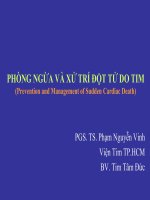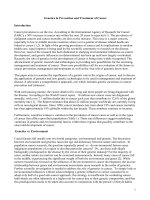CARDIAC DEFIBRILLATION – PREDICTION, PREVENTION AND MANAGEMENT OF CARDIOVASCULAR ARRHYTHMIC EVENTS pptx
Bạn đang xem bản rút gọn của tài liệu. Xem và tải ngay bản đầy đủ của tài liệu tại đây (5.5 MB, 188 trang )
CARDIAC DEFIBRILLATION –
PREDICTION, PREVENTION
AND MANAGEMENT OF
CARDIOVASCULAR
ARRHYTHMIC EVENTS
Edited by Joyelle J. Harris
Cardiac Defibrillation – Prediction, Prevention and
Management of Cardiovascular Arrhythmic Events
Edited by Joyelle J. Harris
Published by InTech
Janeza Trdine 9, 51000 Rijeka, Croatia
Copyright © 2011 InTech
All chapters are Open Access distributed under the Creative Commons Attribution 3.0
license, which permits to copy, distribute, transmit, and adapt the work in any medium,
so long as the original work is properly cited. After this work has been published by
InTech, authors have the right to republish it, in whole or part, in any publication of
which they are the author, and to make other personal use of the work. Any republication,
referencing or personal use of the work must explicitly identify the original source.
As for readers, this license allows users to download, copy and build upon published
chapters even for commercial purposes, as long as the author and publisher are properly
credited, which ensures maximum dissemination and a wider impact of our publications.
Notice
Statements and opinions expressed in the chapters are these of the individual contributors
and not necessarily those of the editors or publisher. No responsibility is accepted for the
accuracy of information contained in the published chapters. The publisher assumes no
responsibility for any damage or injury to persons or property arising out of the use of any
materials, instructions, methods or ideas contained in the book.
Publishing Process Manager Romina Krebel
Technical Editor Teodora Smiljanic
Cover Designer Jan Hyrat
Image Copyright CLIPAREA l Custom media, 2011. Used under license from
Shutterstock.com
First published October, 2011
Printed in Croatia
A free online edition of this book is available at www.intechopen.com
Additional hard copies can be obtained from
Cardiac Defibrillation – Prediction, Prevention and Management of
Cardiovascular Arrhythmic Events, Edited by Joyelle J. Harris
p. cm.
ISBN 978-953-307-692-8
free online editions of InTech
Books and Journals can be found at
www.intechopen.com
Contents
Preface IX
Part 1 Defibrillation Introduction and Assessments 1
Chapter 1 Implantable Cardioverter Defibrillators 3
Behzad Ghanavati
Chapter 2 Defibrillation Shock Amplitude, Location and Timing 19
Shimon Rosenheck
Chapter 3 Prognostic Significance of Implantable
Cardioverter-Defibrillator Shocks 41
Dan Blendea, Razvan Dadu and Craig McPherson
Chapter 4 Ventricular Tachyarrhythmias in Implantable
Cardioverter Defibrillator Recipients: Differences
Between Ischemic and Dilated Cardiomyopathies 53
Aldo Casaleggio,
Tiziana Guidotto,
Vincenzo Malavasi and Paolo Rossi
Part 2 Prediction, Prevention, and
Management of Cardiovascular Events 67
Chapter 5 Prediction of Ventricular Arrhythmias
in Patients at Risk of Sudden Cardiac Death 69
K.H. Haugaa, J.P. Amlie and T. Edvardsen
Chapter 6 Prevention of Sudden Death –
Implantable Cardioverter Defibrillator
and/or Ventricular Radiofrequency Ablation 83
Andrea Colella, Marzia Giaccardi,
Antonella Sabatini, Alfredo Zuppiroli and Gian Franco Gensini
Chapter 7 Just in Time Support to Aide
Cardio-Pulmonary Resuscitation 105
Frank A. Drews and Paul M. Picciano
VI Contents
Chapter 8 Electrical Storm in the Era of
Implantable Cardioverter Defibrillators 131
David T. Huang and Darren Traub
Part 3 Applications and Clinical Relevance 147
Chapter 9 Ventricular Arrhythmias Due to
a Transient of Correctable Cause in
MADIT-II Patients: Prevalence and Clinical Relevance 149
Michela Casella, Pasquale Santangeli, Ghaliah Al-Mohani,
Antonio Dello Russo, Francesco Perna,
Stefano Bartoletti, Joseph Gallinghouse, Luigi Di Biase,
Andrea Natale and Claudio Tondo
Chapter 10 ICDs in Clinical Trials:
Assessment of the Effects of Omega-3
Polyunsaturated Fatty Acids from Fish Oils on
Ventricular Tachycardia and Ventricular Fibrillation 155
A. Mirrahimi, L. Chiavaroli, K. Srichaikul,
J.L. Sievenpiper, C.W.C. Kendall and D.J.A. Jenkins
Chapter 11 Application of the Bispectral Index (BIS)
During Deep Sedation for Patients with ICD Testing 163
Małgorzata Kuc, Maciej Kempa, Magdalena A.Wujtewicz,
Radosław Owczuk and Maria Wujtewicz
Preface
Throughout the world, approximately 23 million people suffer from heart failure each
year. Of all patients who experience heart failure, the mortality rate due to sudden
cardiac death (SCD) is between 28% and 68%. SCD is most often due to ventricular
tachycardia (VT) or ventricular fibrillation (VF). To alleviate SCD by VT and VF, one
effective and common treatment is the use of implanted cardioverter-defibrillators
(ICDs).
An ICD is a device that monitors the electrical activity of the user’s heart and delivers
an electrical shock upon detecting certain arrhythmias. While ICDs have decreased the
number of deaths due to sudden cardiac arrhythmic events, studies suggests that
patients with ICDs who receive shocks have a worse prognosis than similar patients
who do not receive shocks.
These poor projections for patients who receive shocks are spurred by several factors.
While the electrical shocks from ICDs save lives, they are also reported to be quite
painful. Therefore, patients who have experienced a shock tend to suffer from
psychological stress and a lower quality of life afterwards. Furthermore, about one
third of ICD patients will experience inappropriate or unnecessary shocks from their
ICDs. Inappropriate shocks have been linked to higher mortality rates in ICD patients.
Other research suggests that after patients receive a shock, heart failure tends to
progress more rapidly. Each of these factors highlights a gap in the body of knowledge
relevant to ICDs. Therefore, a significant amount of research and clinical studies are
needed to guarantee continued improvement for these devices.
One topic worthy of further exploration is the manner in which ICDs detect
arrhythmias. At present, many ICDs use timing to classify heart rhythms. As a result,
some safe rhythms are indistinguishable from life-threatening rhythms that have the
same timing. For example, sinus tachycardia (ST) arrhythmia is safe and occurs during
exercises in which the heart rate rises to about 120 beats per minute. On the other
hand, ventricular tachycardia (VT) arrhythmia is fatal and occurs at the same heart
rate. In spite of similar timing, ST and VT have different morphologies, suggesting that
additional detection mechanisms could help avoid unnecessary shocks in ICD
patients.
X Preface
Another question to consider is how defibrillators can be employed to protect low risk
patients from SCD. Patients who have a high risk of suffering from SCD are most
likely identified by healthcare professionals, and then they receive life-saving ICDs. As
a result, the majority of SCD victims are now low-risk patients because they remain
unidentified and thus unprotected. A suggested answer to this quandary is to increase
public access to defibrillators and to improve real-time, automated training on how to
use such devices.
More research could also be done to determine ways of preventing shocks in ICD
patients. For instance, examining the connection between diet, lifestyle, and
ventricular arrhythmias could lead to such prevention. Diets rich in fish oils have
shown promise in decreasing the risk of arrhythmatic cardiovascular events. However,
to date, only a few studies have examined the use of fish oils to prevent ICD discharge.
More studies could be done to increase this body of knowledge.
The chapters in this book explore the issues posed above in addition to discussing
methods for improving ICDs and answering critical questions about ICD technology.
The authors examine determinants for successful defibrillation and assess patients
who receive defibrillation. Special cases in ICD patients are also considered along with
clinical trials involving patients with defibrillators. The chapters presented herein
contain a comprehensive overview of prediction, prevention, and management of
cardiovascular events.
Joyelle J. Harris, Ph.D.
Exponent Failure Analysis Associates
Phoenix, Arizona
USA
Part 1
Defibrillation Introduction and Assessments
1
Implantable Cardioverter Defibrillators
Behzad Ghanavati
Department of Electrical Engineering, Mahshahr Branch, Islamic Azad University,
Iran
1. Introduction
In recently years, Artificial Neural Networks have been studied extensively and applied in
medical field, and have been demonstrated to have much better pattern recognition ability.
In this chapter we present a VLSI chip to be implemented using 0.35 µm CMOS technology
which is the implantable cardioverter defibrillator (ICDs).
Implantable cardioverter defibrillator is a device which monitors the heart and delivers
electrical shock therapy in the event of a life-threatening arrhythmia.
At present most ICDs are often using time information from leads to classify rhythms.
(Leong, P. H.W &Jabri, M.A November 1995) This means they cannot distinguish some
dangerous rhythms from the safe one, as in the case of ventricular-tachycardia arrhythmia.
(R. Coggins et al., 1995)
Our chip is used to distinguish between two types of arrhythmia; The Sinus Tachycardia
(ST) arrhythmia and the Ventricular Tachycardia (VT) arrhythmia. The ST is a safe
arrhythmia occurs during vigorous exercises and is characterized with rate of
120beat/minute. The VT is a fatal arrhythmia with the same rate. They can be separated
only by detecting the morphology changes in each one. (Acherya,U,R.,2004)
Most morphology changes are appeared in the QRS-complex. The QRS-complex for both the
ST and VT arrhythmia’s are shown in fig.1. (Dale Dublin, 2000)
Since most morphology changes are appeared in the QRS-complex, for classifying the
arrhythmias we must separate QRS complexes from ECG, consequently a new circuit for
detecting QRS is designed. In this circuit the R-R distance between two QRS complexes and
also the pulse width of QRS complex are used to improve the detection algorithm.
By using fuzzy logic and some parameters of ECG (pulse width, R-R interval and peak) we
can separate QRS complex from ECG and after that apply this part to a Neural Network for
classification.
The proposed analog VLSI chip can detect such morphology changes. It has the following
advantages:
It is easily interfaced to the analog signals in an ICD (in contrast to the digital systems
which require analog to digital conversion).
Analog circuits are generally small in area.
Low voltage circuits are used to decrease battery weight and size and to extend battery
life time which required for portable and modern wireless equipment.
Hamming network did not need to have a training system and the reference vectors
determine the weights.
Cardiac Defibrillation
– Prediction, Prevention and Management of Cardiovascular Arrhythmic Events
4
Although temperature variation is a major source of drift problems, no need for
temperature compensation as the human body is considered a stable environment.
Fig. 1. Morphology change of QRS complex for both ST & VT.
This chapter deals with the design of Analog VLSI chip for implantable cardioverter
defibrillator (ICDs). We first present the structure of system. Next, we describe each part
separately and characteristic of each parts are described. Then, We show the circuits that are
used for implementing of each part. Finally, we present the total block diagram of system
with some simulations that verifies the functionality of system.
2. Architecture
The proposed chip consists of 3 main parts:
QRS detector circuit
Extracting QRS from an ECG circuit
Classifying QRS complex circuit
First these parts will be explained separately and then the block diagram of the chip will be
presented.
2.1 QRS detector circuit
The dominant component of the ECG is the QRS complex, which indicates the electrical
depolarization of the muscles in the ventricle of the heart. Several clinical applications
including implantable defibrillator require accurate QRS detection algorithms whiles The
QRS is easily recognized by a human observer.
Various types of automated algorithms were proposed in the literature for detecting QRS.
(K.Akazawa and K.Motoda 2001; Pan.J & Tompkins W.J 1985; Y. Suzuki, 1995) These
algorithms use multiple features of the EGG including RR internal, pulse duration and
amplitude, to detect QRS complexes. By processing several features, it is less likely that
large amplitude but short duration noise would be mistaken for a QRS. Similarly, it is more
likely that a true QRS with low amplitude, but normal width and RR internal would be
correctly detected.
Implantable Cardioverter Defibrillators
5
Fuzzy inference systems are well-suited for this application (fig.2), since detection in this
system based on a few amounts of uncertainly which is very similar to the medical
reasoning process.(O.Wieben, W.J Tompkins & V.X. Afonso 1999) Moreover the decision
process is extremely easy to understand by human; consequently such easy interpretability
allows external changes by experts on the decision process.
In this work, we are using a fuzzy inference system to identify QRS complexes. In this
system QRS complex will be detected provided that a square wave synchronizes with them,
consequently we use a fuzzy controller to adjust this square wave with QRS complexes.R-R
internal, pulse duration and amplitude are features that enter to a controller as inputs
parameter. Fuzzy controller evaluates these features and adjusts the output pulse of VCO to
be synchronized with QRS complexes.
Fig. 2. QRS detection algorithm.
A feedback is used to correct the synchronization process. This feedback is produced by
error between the output pulse of VCO and the pulse that show the width of QRS complex.
This feedback is also enter to controller and processed by fuzzy controller. Finally, the
output of fuzzy controller goes to VCO circuit and makes the output pulse of VCO to be
synchronized with QRS complex (fig.3).
Cardiac Defibrillation
– Prediction, Prevention and Management of Cardiovascular Arrhythmic Events
6
Fig. 3. QRS detection algorithms that is used in this project.
3. Extracting QRS from an ECG circuit
To separate QRS complexes, we passed ECG signals and synchronize VCO trough an analog
median filter. (fig.4). Median Filter passes the median part of the input signals which, in this
case, is QRS complexes.
Fig. 4. Median Filter.
Implantable Cardioverter Defibrillators
7
4. Classifying QRS complexes
The QRS complexes which were detected and separated from the rest of ECG signals are
applied to an arrhythmia classifier. This classifier is used to distinguish between two types
of arrhythmia: The Sinus Tachycardia (ST) arrhythmia and the Ventricular Tachycardia (VT)
arrhythmia. The ST is a safe arrhythmia occurs during vigorous exercises and is
characterized with rate of 120beat/minute. The VT is a fatal arrhythmia with the same rate.
They can be separated only by detecting the morphology changes in each one.
Since the most morphology changes are appeared in the QRS complex, we apply QRS
complex to an arrhythmia classifier to classify it. This arrhythmia classifier consists of three
building blocks: a sample and hold (S/H) circuit, a mapping circuit and a Hamming neural
network classifier. Fig.5 represents a block diagram of the chip. First, the rhythm is inputted
to a sample and hold circuit to obtain 10 samples of the input signal. These 10 samples are
inputted to mapping circuits in parallel to map into unit length [-1 1]. The outputs of
mapping circuits are input to Hamming Neural Network, which has two neurons in its
output layer. Each neuron responds to a specified type of the input arrhythmia.
Fig. 5. Block diagram of QRS classifier.
4.1 Hamming Neural Network
A Neural Network classifier is made of a Hamming network, which is a maximum
likelihood classifier network that can be used to determine which of several exemplar
vectors are the most similar to an input vector (Laurene Fausett,1994 & M. B. Menhaj,2000).
Fig.6 shows the simplest structure of a competitive layer.
Fig. 6. A competitive cell.
Cardiac Defibrillation
– Prediction, Prevention and Management of Cardiovascular Arrhythmic Events
8
()acompWP
(1)
*,0
*,1
ii
ii
a
i
(2)
i* is number of the cell that has the highest n
i.
for our application i=1, 2.
In the Hamming Network, reference vector determines the weights (w) of the network.The
hamming distance between input vector (P) and reference vector is calculated by n vector
(equation 3). (Laurene Fausett,1994 & M. B. Menhaj, 2000)
Winner cell is determined with multiplying input vector to weights. The largest value
corresponds to the smallest angle between input and weights vector if they are both of unit
length [-1 1] (Laurene Fausett,1994 & M. B. Menhaj, 2000).
11 12 110 1
21 22 210
2
cos
cos
WW W
nWP P
WW W
(3)
5. Circuit design
The designing method of blocks show in fig.5 is given below:
5.1 Sample and hold (S&H) circuit
The Sample and hold delay circuit is made of 10 cascaded stages to obtain 10 samples of the
input pulse. Fig. 7 shows S/H circuit.
Fig. 7. Three stages of S/H circuit.
Two-phase non-overlapping clock (CK
1
,CK
2
) is used to control S/H. The sampled signal x
i
then are inputted mapping circuit through another analog switch m
i
controlled by CK
3
. The
timing diagram of CK
1
, CK
2
, CK
3
and the simulation result of the 1
st
stage of sample and
hold circuit are shown in fig. 8.
Implantable Cardioverter Defibrillators
9
Fig. 8. (a) Input to S/H circuit. (b) Sampling signal of the 1st stage. (c) CK1. (d) CK2. (e) CK3.
In Fig. 8, the input rhythm of ST is applied to the S/H circuit and output of 1
st
stage is
shown.
5.2 Mapping circuit
Before applying sampled data to Neural Network We have to map them into unit length
[-1 1]. Figure 9 shows schematic of mapping circuit.
Fig. 9. Mapping circuit.
Cardiac Defibrillation
– Prediction, Prevention and Management of Cardiovascular Arrhythmic Events
10
We use a simple differential pair in order to map input signal (sampled data) to unit length
space [-1, 1]. By changing V
ref
and W/L ratio of input stage of differential pair, we can map
any space to unit length space. (Wilamowski, B 1999)
5.3 Hamming Neural Network classifier
The Hamming Network consists of two groups of synapses and two layers of neurons. The
first group with weight vector W
1
= (W
11
, W
12
, W
13
, …, W
115
) is connected to first neuron
layer. The second layer with weight vector W
2
= (W
21
, W
22
, W
23
, …, W
215
) is connected to
second neuron layer, each neuron in the output layer responds to a specified class of input
arrhythmia. Figure 10 shows the structure of Network
Fig. 10. Hamming Neural Network.
5.3.1 Synapse
The computation of inner product between input signal and the local interconnection
weight is called synapse and is mostly done by using an analog multiplier.(S. T.Lee; H.
Shawkey 1999)
We use a new low voltage low power four quadrant analog multiplier as a synapse. Since
output of a synapse is current, output of 10 synapses can be summed at a single node of
circuit.
The circuit consists of four quadratic cells is shown in figure 11 where the relationship
between the input current, I
in
, and the output current, I
out
, are quadratic. The quadratic cell
is made of two transistors M
n
and M
p
which are biased to operate in triode region and M
c
which operates at saturation region.
Implantable Cardioverter Defibrillators
11
Fig. 11. Quadratic cell.
If M
n
and M
p
have the same transconductance,
p p ox n n ox
WW
k μ Ckμ Ck
LL
Then, it
can be easily shown that the voltage (V
in
) and the current (I
out
) are given by
in in
VaIb
(4)
2
out in
IkcI (5)
Where a, b and c are
DD tn tp
DD tp tn DD tp tn
V(V V)
1
,
k(2V V V ) 2V V V
and
DD DD tp
tn
DD tp tn
2V (V V )
V
2V V V
respectively.
Figure 12 shows the proposed four quadrant current multiplier circuit. The input currents of
a multiplier are the sum of currents I
X
and I
Y
and the subtraction of the input currents I
X
and
I
Y
. By using quadratic relationship between input and output currents which are derived
from Equation (5) drain currents of M
C1
, M
C2
, M
C3
and M
C4
would be
2
1
[( )]
CXY
IkcaII (6)
2
2
[( )]
CXY
IkcaII (7)
2
3
[( )]
CXY
IkcaII
(8)
2
4
[( )]
CXY
IkcaII (9)
Cardiac Defibrillation
– Prediction, Prevention and Management of Cardiovascular Arrhythmic Events
12
Fig. 12. Multiplier as a synapse.
According to Fig. 12, I
O1
is the combination of I
C1
and I
C2
while I
O2
is the combination of I
C3
and I
C4
. I
O1
and I
O2
can be shown as
22 2
1
[2 2 ( ) ]
OXY
IkcaII (10)
22 2
2
[2 2 ( ) ]
OXY
IkcaII
(11)
The output current of the four quadrant current multiplier I
out
is the difference between I
O1
and I
O2
and is given by
2
12
8
OUT O O X Y
IIIkaII
(12)
Fig. 13 Shows DC characteristic of current multiplier circuit under input current ranging
from -20 μA to 20 μA.
Fig. 13. DC transfer characteristic of four quadrant current multiplier.
Implantable Cardioverter Defibrillators
13
5.3.2 Winner take all
The function of the WTA is to accept input signals, compare their values and produce a high
digital output value (logic ‘one’) corresponding to the largest input, while all other digital
outputs are set to low output value (logic ‘zero’).(J.Ramirez-Angulo et al., 2005)
Fig. 14 shows the block diagram of the WTA circuit. The circuit includes a 2-input current
maximum selector with a simple voltage inverter.(.Ramirez-Angulo et al., 2005)
Fig. 14. Winner take all circuit.
5.3.3 The current max selector
The 2-input current maximum selector is shown in Fig. 15. The proposed current max
selector has 2 input branches and each branch consists of an FVF (R.G. Carvajal et al., 2005),
which is formed by voltage follower M
ai
, and current sensing transistor M
ci
.
Fig. 15. 2-input max circuit.









